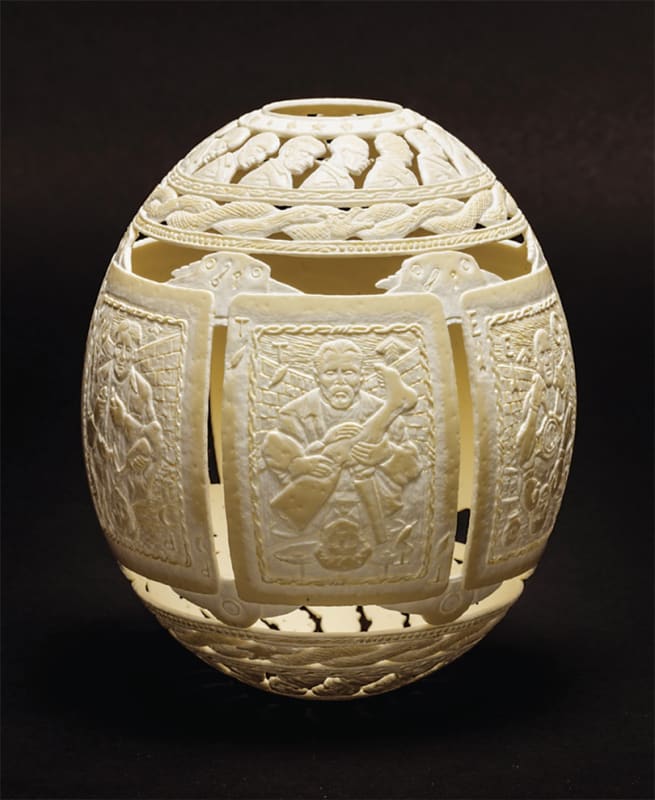Gil Batle used to go to Walmart in Southern California and scrutinize the cashiers. He’d keep his eyes peeled for anyone who was new, bored, or unremittingly sloppy. When he found his mark, Batle would visit his or her checkout line with some expensive appliance in tow and would pay for it with a money order. But the piece of paper he’d hand over for his big-ticket item was an exquisitely made drawing–a counterfeit. Batle would then sell his stealthily looted merchandise on the street for cash to support his crystal meth addiction. His skills as a master forger got him into a lot of trouble; Batle spent about twenty years in and out of jail, much of it for fraud. However, in prison, where he’d supply his fellow inmates with drawings or tattoos, his talents as an artist earned him respect and, perhaps most importantly, protection. Having been free for about a decade, Batle now makes artwork on a remote island in the Philippines. But the sculptures and drawings on view in his second solo outing with Ricco/Maresca gallery illustrated the dark days of his numerous incarcerations in fastidious, lurid detail. Crime and art overlapped beautifully, hypnotically–as in a classic EC horror comic.

Gil Batle, Kite Deck, 2017, ostrich egg shell, 6.5 x 5 x 5 in.
With a high-speed dental drill, Batle carves his harrowing tableaux into the surfaces of emptied ostrich eggs. Each one takes about a month to complete. virtually every stripe of misery gets its due–rape, murder, suicide, poverty, hopelessness, revenge–in a style that seems a synthesis of Robert Crumb, Hieronymus Bosch, and those eerie little illustrations from the Ellesmere manuscript. Nineteen of the artist’s eggs were installed throughout the gallery and protected by glass domes, as if they were dainty Victorian keepsakes. Because the pieces were placed close together on long, low plinths, a 360-degree view of each work was difficult to find. But observers were encouraged to linger, as a tidy row of magnifying glasses was available in the gallery for anyone willing to spend more than a few minutes poring over one of these exactingly created objects.
Abducted, 2017, tells the story of a dentist Batle knew, named Dr. Simmons, who received two life sentences for killing his family. (One day Simmons went to the police to file a missing-person report, claiming that his wife and son were taken hostage by aliens–a few weeks later, authorities found their bodies buried in a field.) The egg is embellished with UFO battalions, an alien judge, cops, prison watchtowers, and a pair of disinterred skulls. In one part of the work, an extraterrestrial tenderly gifts Simmons with a noose. Nearby, there’s a rendering of the dentist in his cell with a bedsheet tied around his neck, writing a farewell letter. Kite Deck, 2017, takes its name from the sets of altered playing cards prison gang members use for secret communications. Panels from the egg, modeled after different card suits, depict, among other things, a shiv growing from the earth like a root vegetable; a doctor carrying a saw and severed limbs; and an old junkie with a needle in his arm hovering above a spectral Death, who is clutching his scythe, patiently waiting. A braid of hungry serpents, devouring one another, encircles the top of the egg.
Perhaps the most riveting sculpture in the show didn’t come with a story written by the artist explaining the work’s genesis. And it was certainly one of the more gruesome pieces, emblazoned with all manner of violation. Panderer, 2016, features a picture of a man facedown on a jailhouse floor. Knives have been stabbed into his head and back; the handle of a toilet plunger is shoved up his ass. Yet its most striking detail is the delicate frieze that rings it: a tiny row of erect cocks that become a grouping of vaginas, then puckered assholes, then a sextet of wide-open mouths. It’s a circle of life as vicious trap, grimly realized and mordantly funny.

